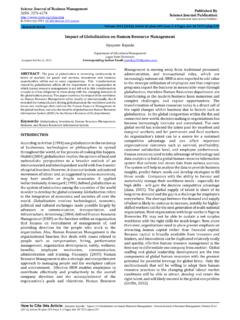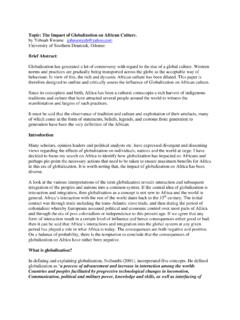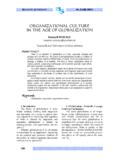Transcription of Globalization of Technology: Issues in Technology …
1 UNESCO EOLSSSAMPLE CHAPTERSGLOBALIZATION OF Technology Globalization of Technology : Issues in Technology transfer and technological capability Building - Prasada Reddy Encyclopedia of Life Support Systems (EOLSS) Globalization OF Technology : Issues IN Technology transfer AND technological capability BUILDING Prasada Reddy Research Policy Institute, Lund University, Sweden Keywords: Globalisation, techno-economic paradigms, leapfrogging, catching up, latecomer industrialisation, developing countries, new technologies, information and communication technologies, biotechnology, knowledge networks, Technology transfer , innovation, technological capability , competition, transnational corporations, science parks Contents 1. Introduction 2. Dynamics of global business environment 3. New techno-economic paradigm and latecomer industrialization 4. Knowledge networks Global intra-organizational networks Global inter-organizational networks 5.
2 Foreign direct investment and Technology transfer 6. Social effects of Technology 7. Conclusion Glossary Bibliography Biographical Sketch Summary Since the 1980s, a number of changes have taken place in the economic, political, and social spheres worldwide, creating a relatively more interdependent world. This process, which is labeled Globalization , is mainly driven by two factors: the liberalization of economies worldwide and the emergence of new technologies, where the latter act both as a driving force and an enabling factor. Globalization is opening up new windows of opportunity for countries and firms to catch up with the leaders, but at the same time it also poses several challenges in terms of entry barriers. While some developing countries have been able to integrate themselves with the global economy and catch up with the more advanced countries, many others have failed to overcome the challenges and feel marginalized.
3 Today, the global economy is mainly characterized by competition. The liberalization of economies has opened up previously protected domestic markets, making competition a global issue . The emerging new technologies, such as information and communication technologies and biotechnology, have not only created new products, but through their diffusion have also changed the characteristic features of traditional products. The new technologies have a close proximity to basic sciences and the development of some of these technologies does not require much previous industrial UNESCO EOLSSSAMPLE CHAPTERSGLOBALIZATION OF Technology Globalization of Technology : Issues in Technology transfer and technological capability Building - Prasada Reddy Encyclopedia of Life Support Systems (EOLSS) experience or huge capital investments. This has given an opportunity to countries with adequate pools of scientifically and technically trained people to increase the pace of their industrialization.
4 At the same time, many innovations in technologies are occurring through inputs from different disciplines of science, compelling companies to form alliances with other firms and/or universities in their research and development activities. As a result, Technology has become a key factor of competitive advantage both for nations and firms. This importance of Technology has also changed the patterns of Technology transfer and has implications for technological capability building, particularly in developing countries. The main objective of this essay is to guide the reader through the global trends in different aspects of the economy and society in an integrated manner for a better understanding of the impacts of Globalization . The essay is expected to help the reader in understanding how the technological changes are leading to restructuring of economies and societies world-wide and what implications such changes hold for less advanced economies and societies.
5 The text illustrates the Issues with appropriate examples where necessary. This theme paper, which addresses the Issues covered under it at a broader level, is organized as follows: Section 1 introduces the theme and identifies the Issues for exploration. Section 2 describes the dynamics of the global business environment, setting the background for the specific Issues to be addressed by the individual papers under the theme. Section 3 examines the characteristics of the new technologies, the new techno-economic paradigm, and analyzes the opportunities and challenges they provide for developing countries to catch up with the industrialized world. Section 4 presents the salient features of the knowledge networks that are formed by the enterprises in order to develop new technologies and meet the global competition. Section 5 discusses the successful condition for Technology transfer and absorption.
6 Section 6 examines the societal implications of Globalization of Technology . Section 7 concludes. 1. Introduction Since the 1980s, a number of crucial changes have been taking place in the economic, political, and social spheres, creating a relatively more interdependent world. This process, which is labeled Globalization , is seen as offering unprecedented benefits, leading to enhancement of welfare to people worldwide. This process has opened up windows of opportunity for several countries to integrate themselves with the more advanced economies. Simultaneously, some countries feel that the Globalization has marginalized them by creating several new barriers to entry into the world markets, the most important of such barriers being technological capabilities. The characteristic features of international economic transactions have changed considerably, during the last two decades, mainly because of two factors: first, the liberalization and opening up of economies worldwide; and second, the emergence of new technologies which enabled as well as compelled the shift towards Globalization .
7 UNESCO EOLSSSAMPLE CHAPTERSGLOBALIZATION OF Technology Globalization of Technology : Issues in Technology transfer and technological capability Building - Prasada Reddy Encyclopedia of Life Support Systems (EOLSS) The liberalization of economies has brought about several changes in trade, investments and technologies. Traditionally, international trade involved several different agents and consumers located in various countries creating economic relationships between them. But now much of the international trade takes place between the affiliates of the same firm (intra-firm) and between firms (inter-firm). This pattern of trade is creating internationally integrated production networks by facilitating new ways of organizing industries. The flows of foreign direct investment (FDI) and portfolio investments are facilitating the geographical spread of location and ownership of enterprises among countries.
8 This has significant implications for Technology diffusion and transfer to developing countries and the process of technological capability building in those countries. The emergence of new technologies is acting both as a driving force and an enabling factor to Globalization . The pattern of innovation shows that the development of new technologies requires input from several different disciplines. At the same time, these technologies are changing rapidly, shortening the product life-cycles. In combination, these factors are increasing the research and development (R&D) costs for companies, compelling them to recoup their investments as quickly as possible by diffusing their products and/or technologies in geographically wider markets. Rising Technology development costs also call for cost reduction in other areas of operations.
9 Consequently, companies are seeking to locate specific activities in the locations best suited for such activities, leading to a global division of labor. The new technologies are also facilitating such reorganization of operations by companies. For instance, the new information and communication technologies (ICT) allow companies to deploy resources and operations on a global scale and at the same time maintain central control. It is now technically feasible to build up reliable information and communication networks linking the headquarters of a company with its affiliates, suppliers, customers and even competitors worldwide. As a result of these forces, the new technologies have opened up opportunities for some developing countries or latecomers to industrialization to integrate themselves with the global economy. At the same time, the new technologies have significantly changed the way the industrial activities are organized and the skill requirements for participation in the production.
10 In other words, the new technologies have also brought about changes at the societal level in general. In combination with the liberalization, they have also changed the context, the conditions, and the channels under which technologies are diffused or transferred. These pose challenges for technological capability building in developing countries or latecomers to industrialization. They have to face up to Issues such as which types of technologies to focus on, how to go about acquiring advanced technologies, which type of policy and business environment leads to successful industrialization and economic growth, and so on. The main aim of this theme is to examine the driving forces behind the Globalization of Technology and its implications for Technology transfer to, and technological capability building in, developing countries. The theme examines several specific Issues , such as the new techno-economic paradigm and latecomer industrialization, global knowledge networks, foreign direct investment and Technology transfer , and the social effects of Globalization of Technology .


















